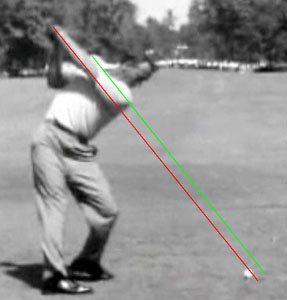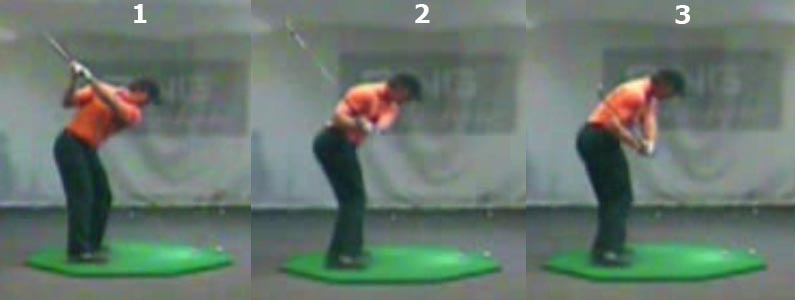|
|
Post by gmbtempe on Mar 15, 2010 11:00:18 GMT -5
Greg, Take a straight piece of wood, and tape another straight shorter stick of wood at right angles to the first stick - like a crucifixion stand. The second stick represents the cross stick. Now tilt the straight stick forwards (to create the equivalent of a spinal bend angle) and also tilt it to the right (so that the right shoulder end is lower than the left shoulder end of the cross-stick). Then simply rotate the straight stick clockwise - without altering the degree of rightwards-tilt. Doesn't the right shoulder end of the cross stick end up slightly higher than the left shoulder end of the cross-stick - without any tilting of the straight stick to the left during its rotational motion? Jeff. yes it can but there is no way a golfer can swing the arms on an inside track and behind if the initial movement is a right shoulder tilts to the right, at least I cannot conceptually of physiologically seem to do it. |
|
|
|
Post by imperfectgolfer on Mar 15, 2010 11:12:47 GMT -5
Greg, The right shoulder doesn't tilt to the right. It's the spine that is tilted to the right to a small degree. The spine is tilted a mere 6 degrees to the right. See my spine motion in this swing video lesson. www.youtube.com/watch?v=b293B4Z6mksWatch the first 35 seconds. Note that I maintain a rightwards-tilted spine during the backswing pivot motion. Note that my right shoulder moves slightly upwards - because of the rightwards spinal tilt. It's a perfectly natural/physiological upper torso rotational motion. Jeff. |
|
|
|
Post by danadahlquist on Mar 15, 2010 14:51:11 GMT -5
Palmer had a steeper shoulder turn than what we do. Ill post tonight more
|
|
|
|
Post by imperfectgolfer on Mar 15, 2010 17:20:48 GMT -5
Dana, I agree that Palmer had a steeper shoulder turn angle.  However, his steeper shoulder turn angle is primarily related to his greater degree of spinal bend, although part of its is due to the fact that he lifts his right pelvis higher than his left pelvis during the backswing. The same "steeper shoulder turn angle" phenomenon is seen in Hardy OPS golfers who have 35-45 degrees of spinal bend. Here is Jeff Ritter - a prototypical Hardy OPS golfer.  Any golfer who has more-than-average spinal bend is going to likely have a steeper shoulder turn angle - because it is biomechanically natural for the shoulders to rotate perpendicularly around the spinal axis. Jeff. |
|
|
|
Post by danadahlquist on Mar 16, 2010 11:33:53 GMT -5
In your video at :30 you mean to tell me you have no spine extending and or tilting leftwards??
I would disagree.
Not sure about the Jeff ritter image. What are you trying to say. Hes going to pull that ball no doubt.
|
|
|
|
Post by gmbtempe on Mar 16, 2010 11:57:14 GMT -5
Not sure about the Jeff ritter image. What are you trying to say. Hes going to pull that ball no doubt. Why do you say that on that swing pictures? I have watched Jeff hit balls, he is one teacher who can really demonstrate what he is doing. |
|
|
|
Post by imperfectgolfer on Mar 16, 2010 19:46:02 GMT -5
Dana,
I am definitely not tilting left when rotating my upper torso around my rightwards tilted spine.
I have no idea what you mean by "extending" the spine. I believe that my spine length remains unchanged. I am simply rotating my shoulders naturally/perpendicularly around my rightwards-tilted spine - within my range of comfort. I am deliberately trying not to lift-up or change my spine angle bend, or spine tilt angle, during my upper torso rotation.
I can see nothing in Jeff Ritter's OPS swing action to suggest that he would likely pull the ball. What do you see?
Jeff.
|
|
|
|
Post by siteseer2 on Mar 16, 2010 21:10:26 GMT -5
In your video at :30 you mean to tell me you have no spine extending and or tilting leftwards?? I would disagree. Not sure about the Jeff ritter image. What are you trying to say. Hes going to pull that ball no doubt. Agreed Dana... his left arm is SO far inside the baseline at p5.8 (pic 3), and he has spun like a top with punch elbow, the only move to get the sweetspot OUT, is to roll #3 and he'll hit face pulls or pull fades... on 2d thought he could also, employ a hitters action and extend with the right tricep, in more of a cf move... |
|
|
|
Post by imperfectgolfer on Mar 16, 2010 21:59:55 GMT -5
Siteseer2
You wrote-: "Agreed Dana... his left arm is SO far inside the baseline at p5.8 (pic 3), and he has spun like a top with punch elbow, the only move to get the sweetspot OUT, is to roll #3 and he'll hit face pulls or pull fades...on 2d thought he could also, employ a hitters action and extend with the right tricep, in more of a cf move... "
You seemingly don't have any understanding of the Hardy OPS swing style.
A Hardy OPS golfer would never use a TGM hitter's action.
A Hardy OPS golfer should have no problem getting the sweetspot out during his mid-late downswing. A Hardy OPS golfer also doesn't have to use a lot of PA#3 roll action because he keeps the clubface relatively closed to the clubhead arc - compared to a traditional TGM swinger's action. That's why they get their right elbow behind their right hip in a punch elbow location (rather than in front of the right hip).
A Hardy OPS golfer must "spin like a top", because he intentionally uses a centralised spinal axis and rotates the lower/upper torso as a single unit around that centralised axis. That swing action, which is associated with a shallow clubshaft plane through impact, can predispose to pulled shots if the golfer's timing is off. That usually only happens in novice Hardy OPS golfers and "pulled shots" should never be a problem for a skilled Hardy OPS golfer like Jeff Ritter.
Jeff.
|
|
|
|
Post by iteachgolf on Mar 16, 2010 23:14:04 GMT -5
Jeff, Jim Hardy guys roll #3 a lot and many tip out in doing so because the arms are so deep. All swings on the elbow plane have to have a good amount of #3 roll to kick the sweetspot out to the ball (larger #3 angle). Siteseer has actually spent a ton of time with Mr. Hardy in person and took lessons from him for years. I think he has a pretty good understanding of both the OPS and the use of PA#3. Btw I talked to and filmed Scott McCarron for 18 holes here at the SD Open and talked to him about his swing for a good 4 hours while he was playing a practice round with Troy Matteson. Here is a video from the last 6 holes where he drew every ball and hit them higher and further (after talking and seeing the video he got the club more on plane in the downswing and on his hands at P6 (not tipping out). Below is a picture where you can see the difference in the later swings than the swings earlier in the round where he missed with pulls and cuts. I would see Hardy's pattern lends itself to pulls and overcuts as a miss. Many S&T guys get too shallow and miss with a push. Nothing wrong with either just simply tendency of pattern. Attachments:
|
|
|
|
Post by imperfectgolfer on Mar 17, 2010 9:39:06 GMT -5
Dan,
You stated that a Hardy OPS golfer uses a lot of PA#3 roll because he gets down to the elbow plane. It is true that a golfer will have more PA#3 roll when on a shallower plane through the impact zone. However, I stated that they have less PA#3 roll - compared to a traditional TGM swinger, who uses a takeaway swivel action that requires more left forearm pronation in the backswing action, and therefore more left forearm supination during the release swivel action.
I know that many people think of Scott McCarron as a Hardy OPS golfer, but I don't agree. I think that he more closely resembles a traditional rightwards-centered backswing action swing style golfer (like Stuart Appleby) rather than a prototypical Hardy OPS golfer (like Jeff Ritter) for the following reasons.
1) He has a narrow stance.
2) He has a rightwards-tilted spine at address.
3) He rotates his upper torso around his rightwards tilted spine.
4) He uses a takeaway swivel action that gets the toe of the club facing skywards at the end-takeaway position.
5) He uses a pelvic shift-rotation movement, followed by a shoulder rotation movement in his early downswing - rather than turning both the lower/upper torso at the same time. He has a lot of secondary axis tilt, while a Hardy OPS golfer should maintain a centralised spine.
6) He uses a release swivel action in his downswing, rather than a right arm throw action with a punch elbow motion.
7) His arms exit high in his finish action - exiting at the level of his shoulders, rather than being below shoulder level.
8) He uses a crossover finish swivel action in his finish action.
What should I be looking for in those still images of Scott?
Jeff.
|
|
|
|
Post by iteachgolf on Mar 17, 2010 10:55:07 GMT -5
Well Scott was in Hardy's DVD's and worked with him for a long time. All swings have secondary axis tilt at impact. Hardy guys have about as much pronation of the left arm at the top as anyone. Look at your own photos you posted of Ritter with a laid off shaft, how do you get there with little forearm rotation? The OPS model just has late loading of #3 (or pronation) but it happens as Hardy prefers a shaft the points outside the baseline at the top of the swing. Ritter rolls #3 a ton which is why he tips out just like the before pictures of McCarron. In the after the club is much more on plane and not getting steeper through the downswing. The roll of #3 is why this shaft is steepening and off plane the entire downswing, also shows why Dana correctly states he will hit face pulls. Attachments:
|
|
|
|
Post by gmbtempe on Mar 17, 2010 11:20:57 GMT -5
I am a little slow but what does "tip out" mean?
|
|
|
|
Post by Richie3Jack on Mar 17, 2010 14:20:31 GMT -5
I am a little slow but what does "tip out" mean? At P6 the clubshaft should be about parallel to the target line. Tipping out the shafts points left of parallel. 3JACK |
|
|
|
Post by gmbtempe on Mar 17, 2010 14:38:12 GMT -5
I am a little slow but what does "tip out" mean? Well going back to the shot being a pull as stated by Dana and tipping out. At P6 the clubshaft should be about parallel to the target line. Tipping out the shafts points left of parallel. 3JACK In the above photo of Ritter I just don't see him doing that to hit a pull, if he is aiming at the left side of the G in "Ping" which looks about right then the arm seems parallel to that or very close, and on top of it we don't know the shot he is trying to hit. I actually like that position. |
|